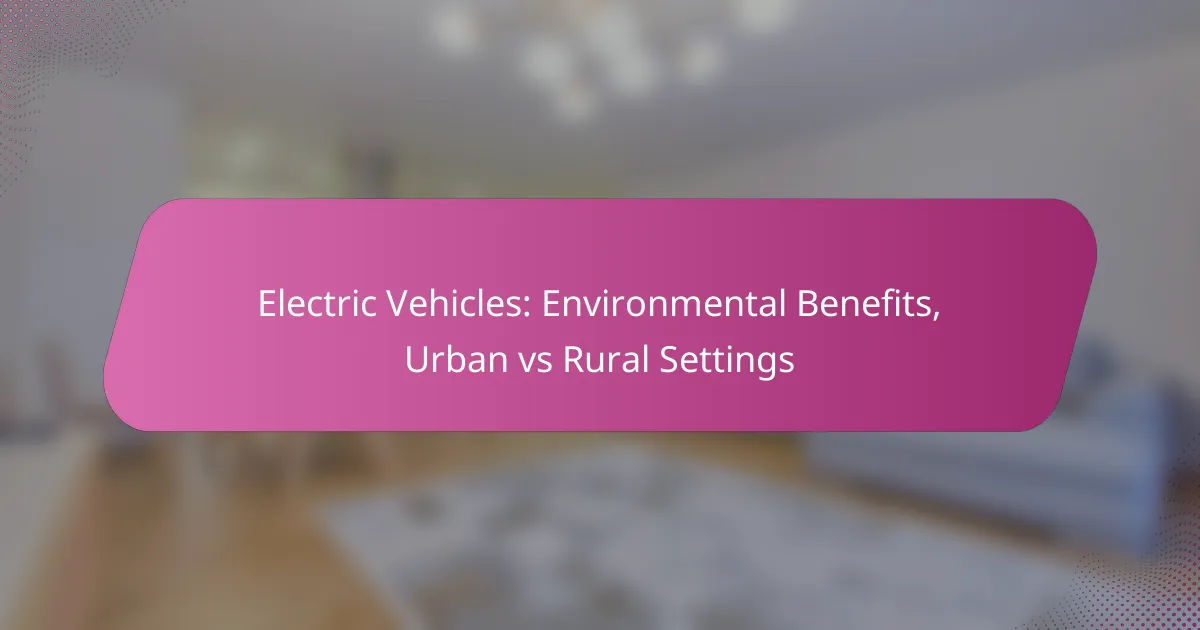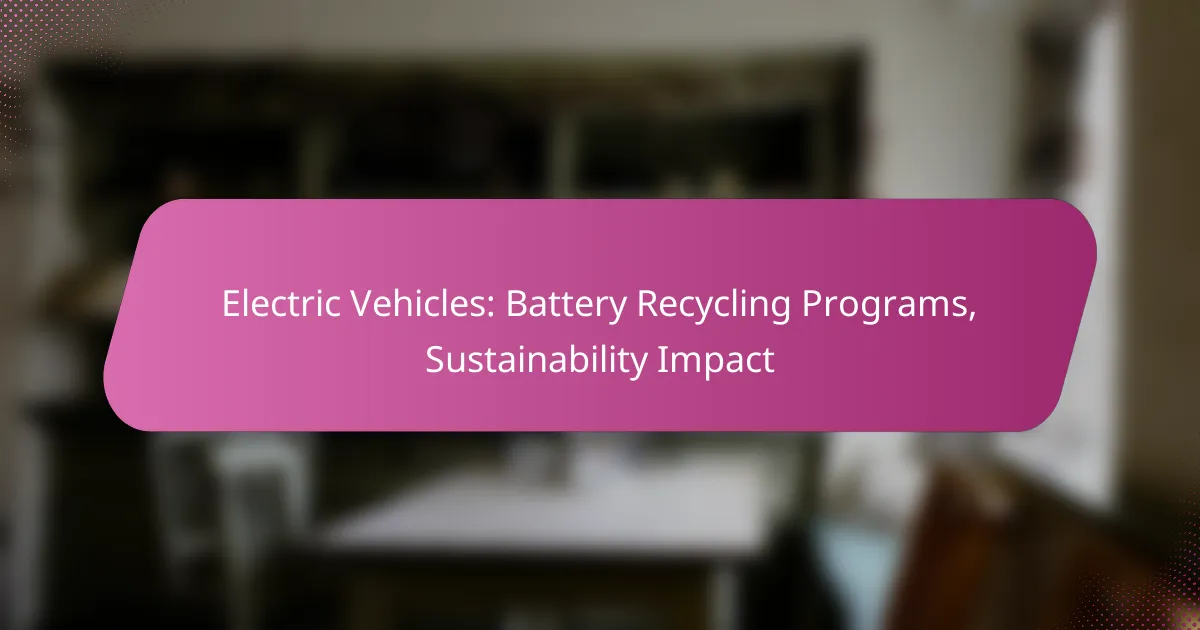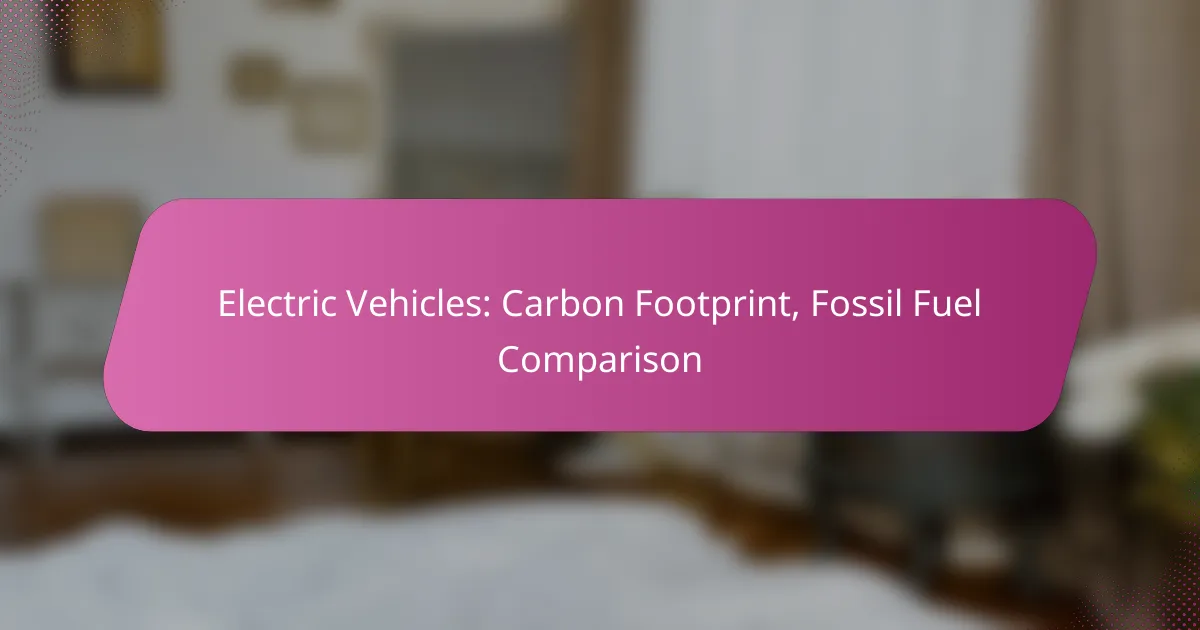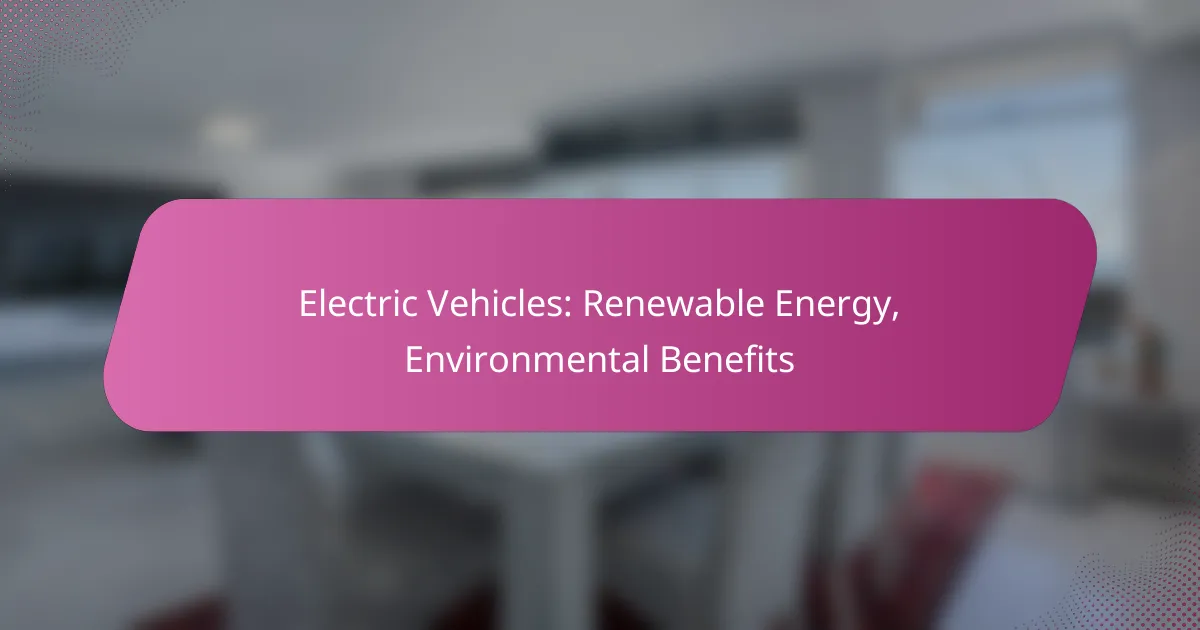Electric vehicles (EVs) offer substantial environmental benefits in both urban and rural settings, though their impact and adoption rates differ significantly. In urban areas, EVs help reduce harmful emissions and enhance air quality, while in rural regions, they promote cleaner energy sources and decrease reliance on fossil fuels. Understanding these dynamics is crucial for fostering sustainable transportation solutions tailored to the unique needs of each environment.
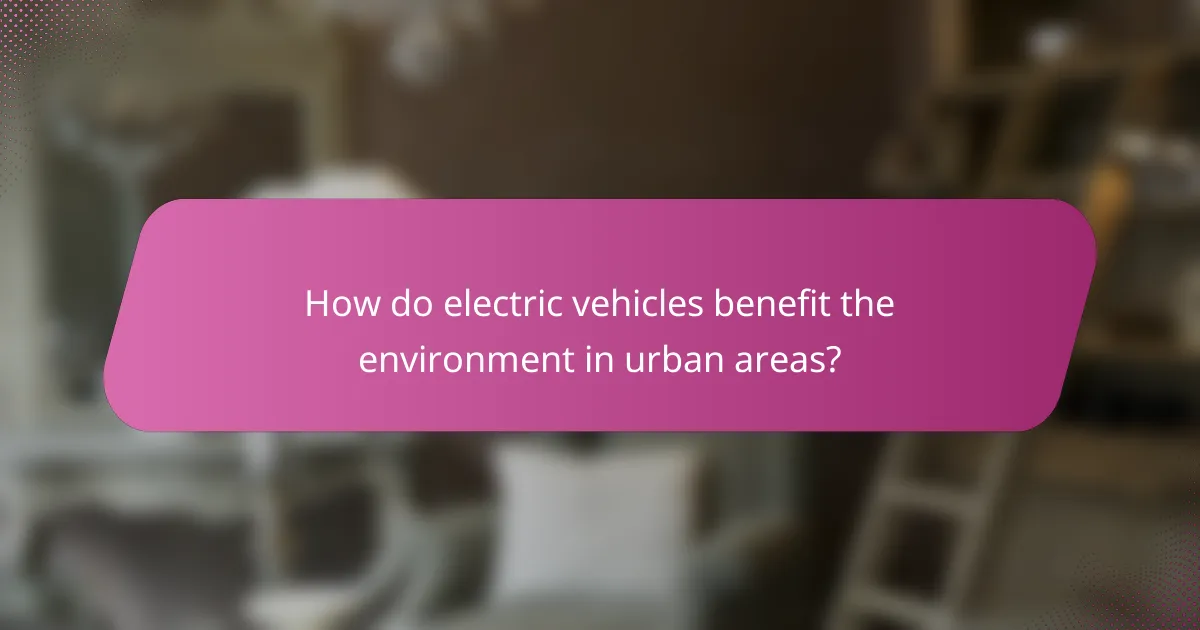
How do electric vehicles benefit the environment in urban areas?
Electric vehicles (EVs) significantly benefit the environment in urban areas by reducing harmful emissions and improving overall air quality. Their adoption leads to cleaner streets and healthier communities, addressing the unique challenges posed by dense populations.
Reduced air pollution
Electric vehicles contribute to reduced air pollution by eliminating tailpipe emissions, which are a major source of harmful pollutants in urban settings. Traditional gasoline and diesel vehicles release nitrogen oxides and particulate matter, which can lead to respiratory problems and other health issues.
By replacing these vehicles with EVs, cities can see a marked decrease in smog and other air quality issues. For instance, cities like Los Angeles have reported improvements in air quality metrics as EV adoption increases.
Lower greenhouse gas emissions
EVs produce lower greenhouse gas emissions compared to conventional vehicles, especially when charged using renewable energy sources. In urban areas, where vehicle density is high, this reduction can significantly impact overall emissions levels.
For example, studies indicate that electric vehicles can reduce lifecycle greenhouse gas emissions by approximately 30-50% compared to gasoline vehicles, depending on the energy mix used for charging. This shift is crucial for urban centers aiming to meet climate goals.
Decreased noise pollution
Electric vehicles are generally quieter than their internal combustion engine counterparts, leading to decreased noise pollution in urban environments. This reduction in noise contributes to a more pleasant living atmosphere, particularly in densely populated areas.
As cities adopt more EVs, residents can expect a significant drop in noise levels, especially during peak traffic hours. The quieter operation of EVs can enhance the quality of life, making urban spaces more enjoyable for walking and outdoor activities.

How do electric vehicles benefit the environment in rural areas?
Electric vehicles (EVs) provide significant environmental benefits in rural areas by reducing emissions and promoting cleaner energy sources. Their adoption can lead to improved air quality and decreased reliance on fossil fuels, which is particularly important for communities with limited public transportation options.
Reduced dependence on fossil fuels
Electric vehicles help decrease reliance on fossil fuels by utilizing electricity, which can be generated from renewable sources like solar or wind. In rural areas, where access to public transport may be limited, EVs offer a cleaner alternative to gasoline-powered vehicles, thus reducing overall fuel consumption.
By transitioning to electric vehicles, rural communities can contribute to national goals of reducing carbon emissions and enhancing energy independence. For instance, using locally sourced renewable energy can further minimize the carbon footprint associated with vehicle operation.
Improved energy efficiency
Electric vehicles are generally more energy-efficient than traditional combustion engines, converting a higher percentage of electrical energy from the grid to power at the wheels. This efficiency is particularly beneficial in rural settings, where longer distances between destinations can lead to higher fuel consumption in conventional vehicles.
In practical terms, EVs can travel more miles per unit of energy consumed, which translates to lower energy costs for rural drivers. Additionally, the use of home solar panels to charge EVs can further enhance energy efficiency and reduce electricity costs, making it a financially viable option for many rural households.

What are the differences in electric vehicle adoption between urban and rural settings?
Electric vehicle (EV) adoption varies significantly between urban and rural areas due to factors like infrastructure, charging accessibility, and consumer preferences. Urban settings typically see higher adoption rates due to better infrastructure and incentives, while rural areas face challenges that can hinder widespread use.
Infrastructure availability
Urban areas generally have more robust infrastructure to support electric vehicles, including dedicated lanes and maintenance facilities. This infrastructure encourages residents to consider EVs as a viable option for daily transportation.
In contrast, rural regions often lack the necessary infrastructure, making it difficult for residents to transition to electric vehicles. Limited public transport options and fewer service centers can deter potential buyers who may be concerned about maintenance and support.
Charging station accessibility
Charging station availability is a critical factor influencing EV adoption. Urban environments usually feature numerous charging stations, often located in convenient areas such as parking lots and shopping centers, making it easier for drivers to charge their vehicles.
Rural areas, however, often have significantly fewer charging stations, which can lead to range anxiety among potential EV owners. To mitigate this, rural residents may need to invest in home charging solutions, which can require upfront costs and proper electrical infrastructure.
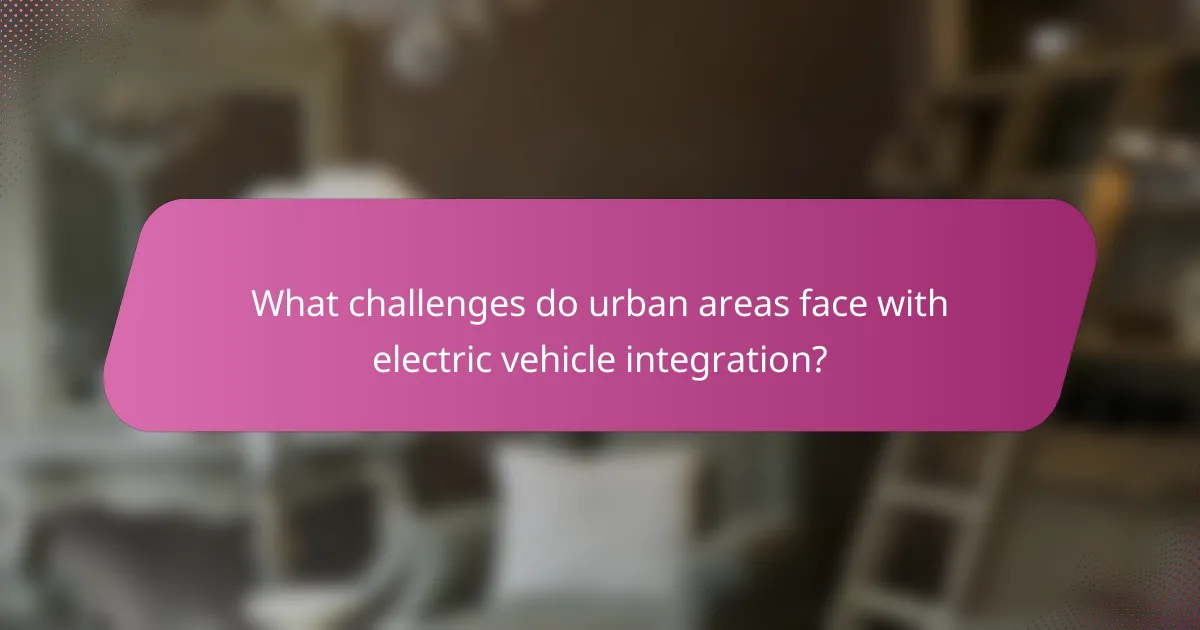
What challenges do urban areas face with electric vehicle integration?
Urban areas encounter several challenges when integrating electric vehicles (EVs), primarily due to their dense populations and infrastructure limitations. Key issues include traffic congestion and limited parking space, which can hinder the effective use and adoption of EVs.
Traffic congestion
Traffic congestion in urban settings can significantly impact the efficiency of electric vehicle use. With high vehicle density, EVs may experience longer travel times, reducing their overall effectiveness as a sustainable transportation option. This congestion can lead to increased energy consumption and longer charging times, as vehicles may need to idle in traffic.
To mitigate congestion, cities can promote carpooling and public transportation options that complement EV use. Implementing dedicated lanes for electric vehicles can also help improve traffic flow and encourage more drivers to switch to electric options.
Limited parking space
Limited parking space is a critical challenge for electric vehicle integration in urban areas. Many cities struggle with insufficient parking facilities, making it difficult for EV owners to find convenient charging stations. This scarcity can deter potential buyers from considering electric vehicles, as the availability of charging infrastructure is a key factor in their adoption.
Urban planners can address this issue by increasing the number of public charging stations and incentivizing the installation of home chargers. Additionally, creating designated EV parking spots can help streamline the parking process and encourage more residents to transition to electric vehicles.

What challenges do rural areas face with electric vehicle integration?
Rural areas encounter unique challenges in integrating electric vehicles (EVs), primarily due to their geographical characteristics and infrastructure limitations. Key issues include longer travel distances and a scarcity of charging stations, which can hinder the adoption of EVs in these regions.
Longer travel distances
In rural settings, residents often face longer travel distances to reach essential services, such as grocery stores or medical facilities. This can pose a challenge for electric vehicle users, as the range of many EVs may not cover these distances without needing to recharge. For example, while some urban drivers may manage short commutes, rural drivers might need to plan trips more carefully to avoid running out of battery.
To mitigate this issue, rural EV owners should consider vehicles with extended range capabilities or those that support fast charging. Understanding the typical travel patterns and planning routes can help ensure that drivers remain within the operational range of their vehicles.
Fewer charging stations
Rural areas typically have fewer charging stations compared to urban environments, making it more challenging for EV owners to find convenient charging options. This scarcity can lead to range anxiety, where drivers worry about their ability to recharge when needed. In some cases, charging stations may be located far apart, requiring careful planning for longer trips.
To address this challenge, rural communities can advocate for the installation of more charging infrastructure, potentially partnering with local businesses to create charging hubs. EV owners should also consider home charging solutions, which can provide a reliable source of power, reducing dependence on public charging networks.
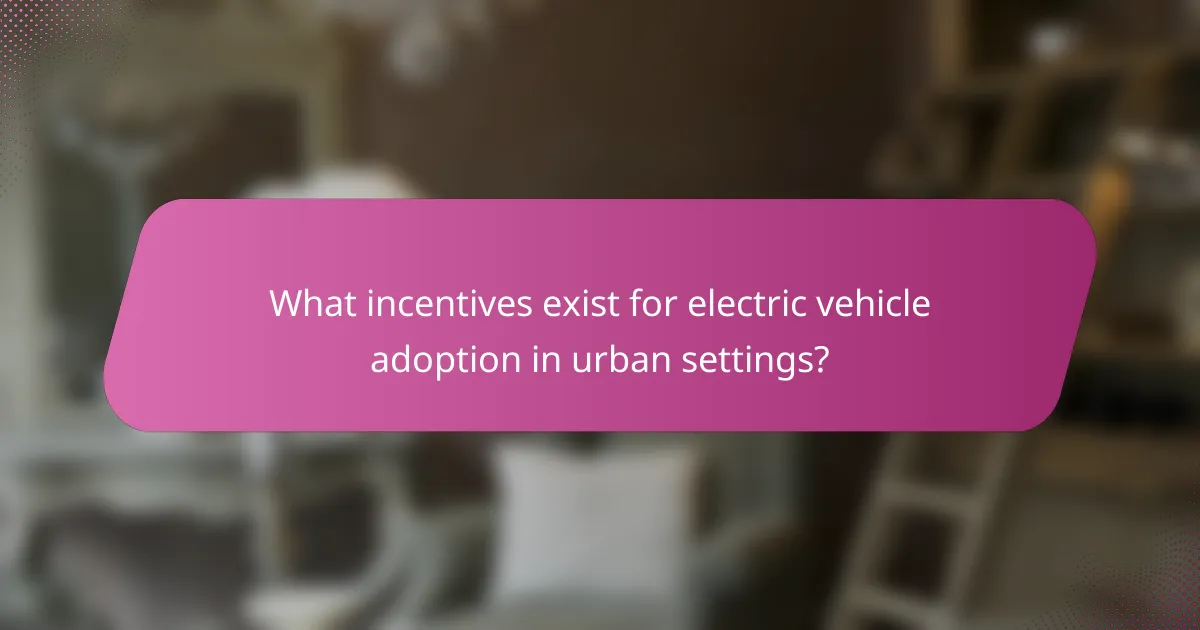
What incentives exist for electric vehicle adoption in urban settings?
In urban settings, various incentives encourage the adoption of electric vehicles (EVs), making them more financially accessible and appealing to residents. These incentives often include tax credits and government rebates, which can significantly reduce the overall cost of purchasing an EV.
Tax credits
Tax credits for electric vehicle purchases can substantially lower the upfront cost. In the United States, for example, buyers may qualify for federal tax credits ranging from a few thousand to over $7,500, depending on the vehicle’s battery capacity and manufacturer. State-level tax credits may also apply, varying by location.
To maximize benefits, potential buyers should research both federal and state tax incentives applicable to their situation. It’s essential to check eligibility requirements and ensure the vehicle qualifies for the maximum credit available.
Government rebates
Government rebates provide direct financial incentives to consumers who purchase electric vehicles. Many cities and states offer rebates that can range from a few hundred to several thousand dollars, effectively lowering the purchase price. For instance, California offers rebates up to $2,000 for eligible EVs.
When considering a government rebate, it’s crucial to understand the application process and any deadlines involved. Some programs may require proof of residency or vehicle registration, so keeping documentation organized can help streamline the process.

What incentives exist for electric vehicle adoption in rural settings?
Rural areas often have unique incentives for electric vehicle (EV) adoption, including federal and state tax credits, grants, and rebates. These incentives aim to reduce the upfront costs of EVs and promote cleaner transportation options in less densely populated regions.
Federal tax credits
In the United States, federal tax credits for electric vehicles can significantly lower the purchase price. Eligible buyers can receive a credit of up to $7,500, depending on the vehicle’s battery capacity. This incentive can make EVs more financially accessible for rural residents.
State and local incentives
Many states offer additional incentives, such as rebates or tax exemptions, specifically for rural areas. For example, some states may provide grants for installing home charging stations or offer reduced registration fees for electric vehicles. These local programs can enhance the financial benefits of switching to an EV.
Charging infrastructure development
Rural regions may receive funding to develop EV charging infrastructure, making it easier for residents to own and operate electric vehicles. This can include grants for installing public charging stations or incentives for businesses to provide charging options. Improved charging access can alleviate range anxiety and encourage more people to consider EVs.
Environmental benefits and sustainability programs
Many rural areas promote sustainability initiatives that align with electric vehicle adoption. Programs aimed at reducing emissions and improving air quality may offer additional support for EV buyers. Participating in these programs can provide not only financial incentives but also contribute to community-wide environmental goals.
